Mattress Construction
September 2021Mattress construction; how are mattresses made?

Updated 2021: Did you know that when people go out looking for a new mattress data shows that most people (80%) try out a mattress in a shop for less than two minutes? Without even asking ‘What’s inside this mattress?’
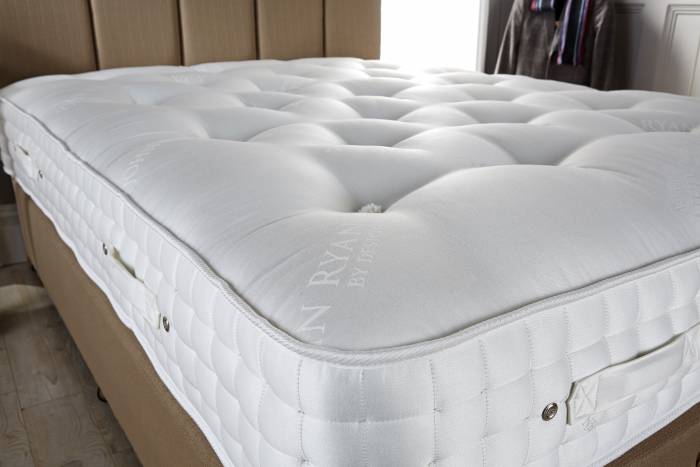
You lie on the mattress and decide whether it is comfortable or not. then move on to the next one. This would be fine if you knew exactly what you were looking at. However, most people have no idea unless they have already found our site.
So most people buying a new bed bounce around for 2 minutes and then make a ‘best guess’ when picking a new bed. Resulting in a random selection of a mattress that could be filled with all sorts of substandard materials.
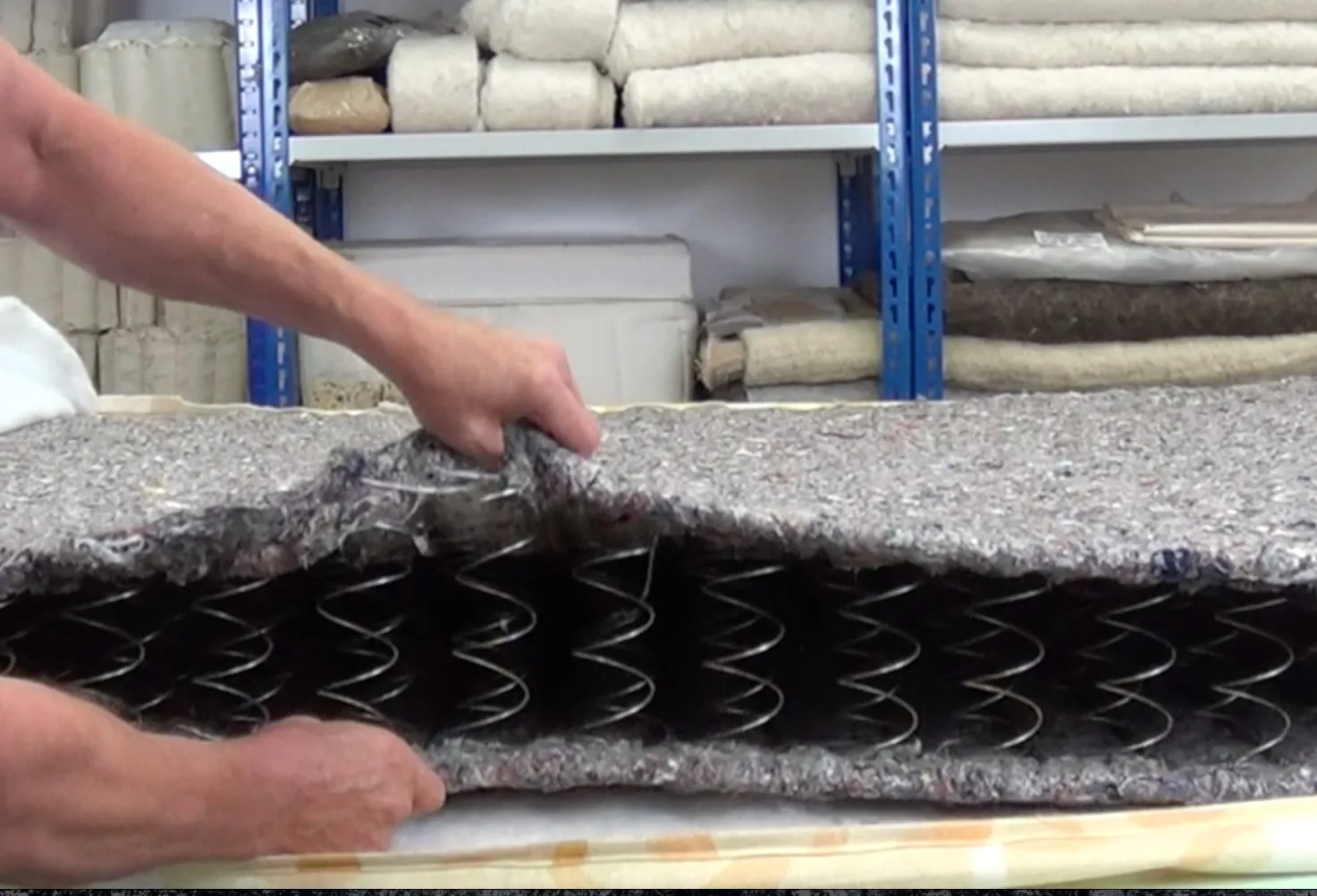
There’s a myriad of other factors that up until now, you didn’t know or even realise you had to take into account when buying a mattress. So let’s look a bit closer at what should be inside a quality mattress so you can avoid the ugly ones!
- What makes a quality mattress?
- Choosing the correct support in a mattress
- Selecting the correct upholstery layers in a bed
- Mattress detailing matters
- How to compare mattresses with examples
What makes a quality mattress?
A suitable quality mattress for you does not mean it has to the most expensive. You may not need sumptuous layers of whatnot, and you may not need multi-thousand springs to support you. The point of this section is for you to know what is actually considered to be a ‘well constructed’ mattress and then you will know the tweaks that can be made to make it suitable for you and your budget.
A quality mattress is made up of 3 main parts:
- Support (Usually provided by a quality spring unit)
- Mattress Upholstery for both comfort and support
- Mattress detailing to finish off your wonderful new bed keeping it neatly together
For this part, we are going to theoretically build a decent mattress and then we will dissect it layer by layer and offer the solutions or compromises that will make it suitable for you and your budget. We promise this will all make sense soon!

1. Choosing the correct mattress support
Before you even consider what fibres or feel you want from the new mattress you need to identify the correct support for your body weight. This is where 99% of people go wrong. Support is offered by spring tensions. These are dictated by your body weight and do not give the overall ‘feel’ of the mattress. Many mattress retailers get this completely wrong which is why you’re left with an uncomfortable mattress.
| Spring Tension | Wire diameter (Gauge) | Weight Range |
|---|---|---|
| Soft | 1.2mm | Bespoke Tension (Please Call) |
| Medium | 1.4mm | Upto 16 stone |
| Firm | 1.6mm | 16 stone plus |
| Extra Firm / Orthopaedic | 1.9mm | 20 stone plus |
In making our mattress we are trying to achieve a good balance of gradual support. This means that there has to be a relation or direct correlation between you, the upholstery and the spring unit. When you lay on the mattress the spring unit should have an element of movement that adjusts to your twists and turns. This movement is fractional and you should not even be aware of it but it should be happening behind the scenes if you will. If it is not moving even slightly, there is something in the mattress that is not right either the upholstery layers are too firm for the spring unit or the spring unit is too firm for the upholstery.
This means that there has to be a relation or direct correlation between you, the upholstery and the spring unit.
2. Upholstery Layers in a mattress matter
Secondly, the upholstery layers are probably the most important part of the feel and comfort of a mattress. Yet buyers skip over these vital details. Upholstery layers or fibres have to be balanced with each other. Upholstery is used in just three parts.
Support
The support layer is the material that is always used directly on top of the spring unit itself. There are numerous support materials from the shocking recycled materials known as poly pads and Saturn pads used in abundance on cheap mattresses, through to bonded wool and cotton etc on high-quality mattresses. This support element is also known as the ‘insulating layer’ insulating the springs from the materials that will eventually go on top.
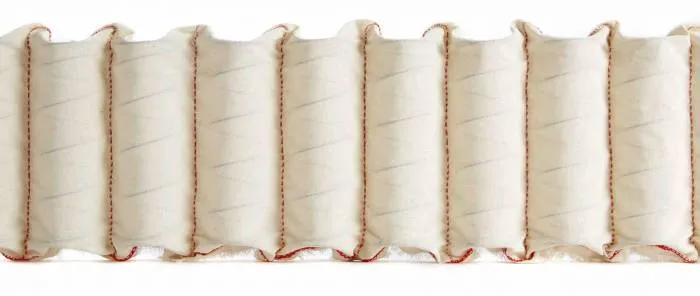
Coir, Mohair and Coarse Cashmere are all high-end insulators found in hand made Natural Fibre mattresses. At the cheaper end of the market, you may find recycled ‘grey fibre’ or foams used as this component.
Bridging layer
This section within the mattress is a tricky one to get right. It has to be based on the Goldilocks theory it cannot be firmer than the support layer beneath and cannot be softer than the materials to be placed on top of it. It has to be just right! As with all upholstery for a mattress, there are numerous materials that can be used and, of course, numerous combinations of blends of materials.

Usually, the bridging layer is made up of Horsehair, Flax or a blend of firmer fibres. In cheaper mattresses, this bridging layer is likely to be a firmer polyester.
Comfort layer
This is the easiest aspect of the build, consisting of soft materials. The comfort layers in a mattress are exactly what it says on the tin. This is the upholstery layer that has to cushion you ‘slightly‘ before the supportive and cushioning elements of the bridging layer kicks in.

There is a vast number of comfort layers which are the topic of discussion in their own right here. However, below is a list of them and their price points to show you what you can expect for your budget.
| Natural fibre | Cost / Availability |
|---|---|
| Alpaca | Very expensive (low supply chain) |
| Bamboo | Average price (good supply chain) |
| Camel | Very expensive (low supply chain) |
| Cashmere | Expensive (good supply chain) |
| Cattle Hair | Average price (good supply chain) |
| Coir | Average price (good supply chain) |
| Cotton | Very expensive (good supply chain) |
| Flax | Average price (good supply chain) |
| Hemp | Average price (good supply chain) |
| Horsetail | Very expensive (low supply chain) |
| Horsehair | Less expensive (good supply chain) |
| Mohair | Expensive (low supply chain) |
| Silk | Very expensive (low supply chain) |
| Vicuna | Very Expensive (Most expensive natural fibre in the world) |
| Wool | Moderate to expensive (good supply chain) |
High end insulators are Coir, Coarse Cashmere and Mohair
High-End Comfort layers like Alpaca are the softest fibres you can find in a mattress

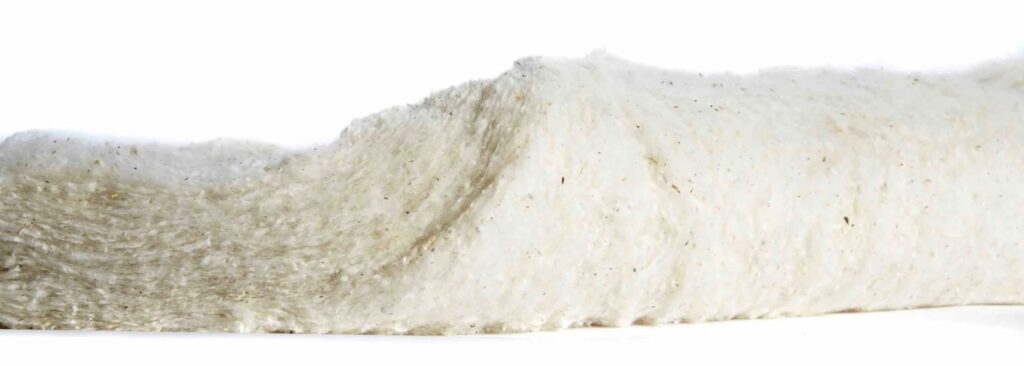
3. Mattress Detailing shows quality
This is where the real mattress quality indicators lie. Even looking at a mattress with no description, the detailing used will immediately tell you how well the mattress is made and whether it is worth the price tag!
Mattress detailing is broken down into the following areas:
- Mattress cover fabric -is it a cheap polyester zip-off cover or a quality Viscose Damask?
- Side stitching – is it machine side stitched or hand side stitched?
- Is the model tufted or quilted? – a tufted mattress is a sign of quality upholstery vs quilted panels
- Two-sided vs One-sided models – a one-sided mattress means you can only use one side leading to settlement issues
Hand side stitching is far superior to a machine side stitch (which is just for show). A hand side stitched mattress shows that the spring unit has been correctly tied in and can only be found on high-end quality mattresses.
The cover fabric will also indicate the quality of the mattress with stretch covers used mainly on entry-level models and Damask used on higher-end mattresses. Tufting should always be expected on any traditional fibre pocket spring mattress along with it being 2-sided. These details will help you quickly avoid substandard mattress models.
Detailing such as hand side stitching seperate the cheap beds from the divine.
Cover fabrics also can be a great indicator of quality. Avoid the cheaper polyester covered beds if possible.
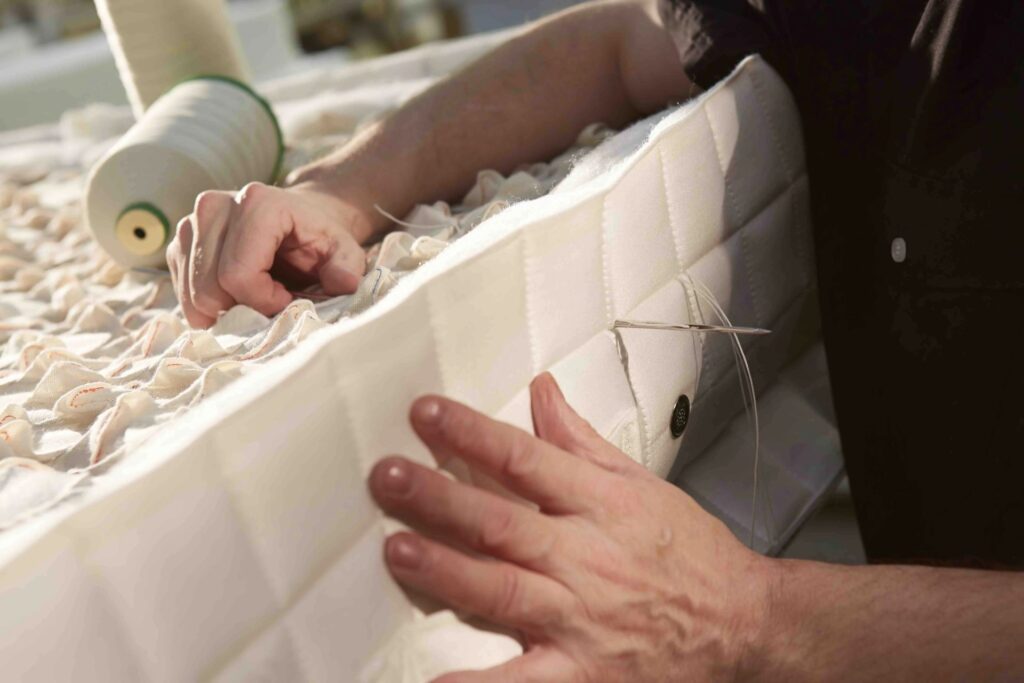
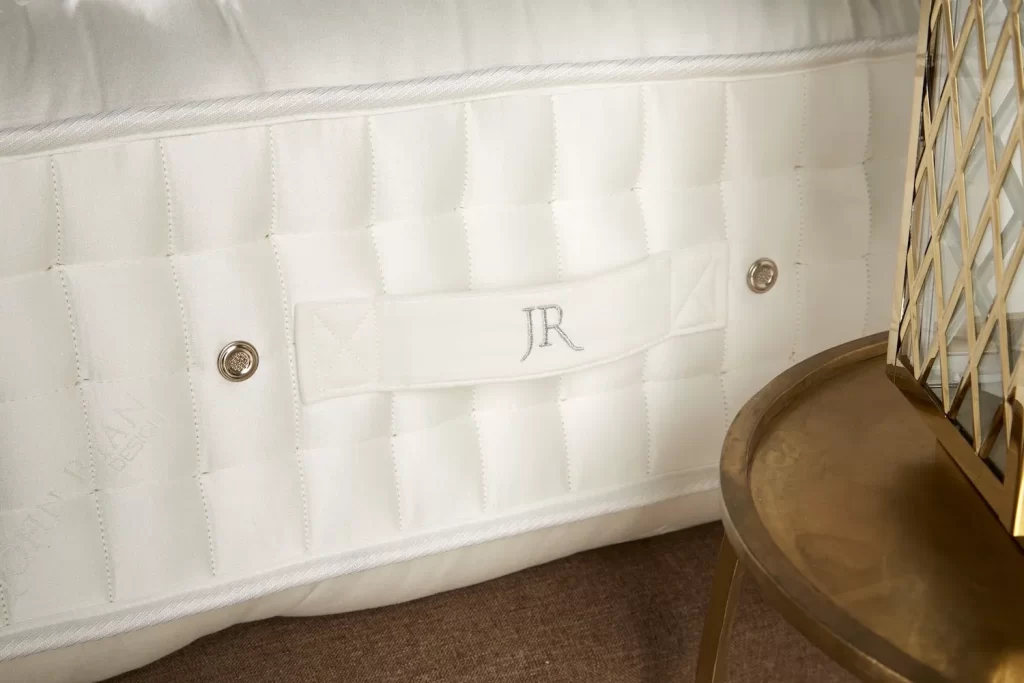
And there we have it the general thesis of mattress construction in a nutshell. But obviously, there is a lot more to it than that. We’re going to take some real-life examples to show you exactly what you need to consider in-depth.
Comparing Vi-spring mattress models
By way of real life example and to put this theory into practice we are going to look at a mattress manufactured by Vi-Spring, one of the countries top and most respected manufacturers. They are one of the few manufacturers who list the components they utilise within the mattress by type and by weight (GSM). We have an article here that lists all the relative comparative models in one place.
If we take the example of their Regal Superb a mid-range model within their collection, we will examine how and why this was constructed. We will then look at a similar spec model to see what elements were changed to make it sit where it does and what differences were made to the construction. Please don’t be put off, this is absolutely fascinating stuff.
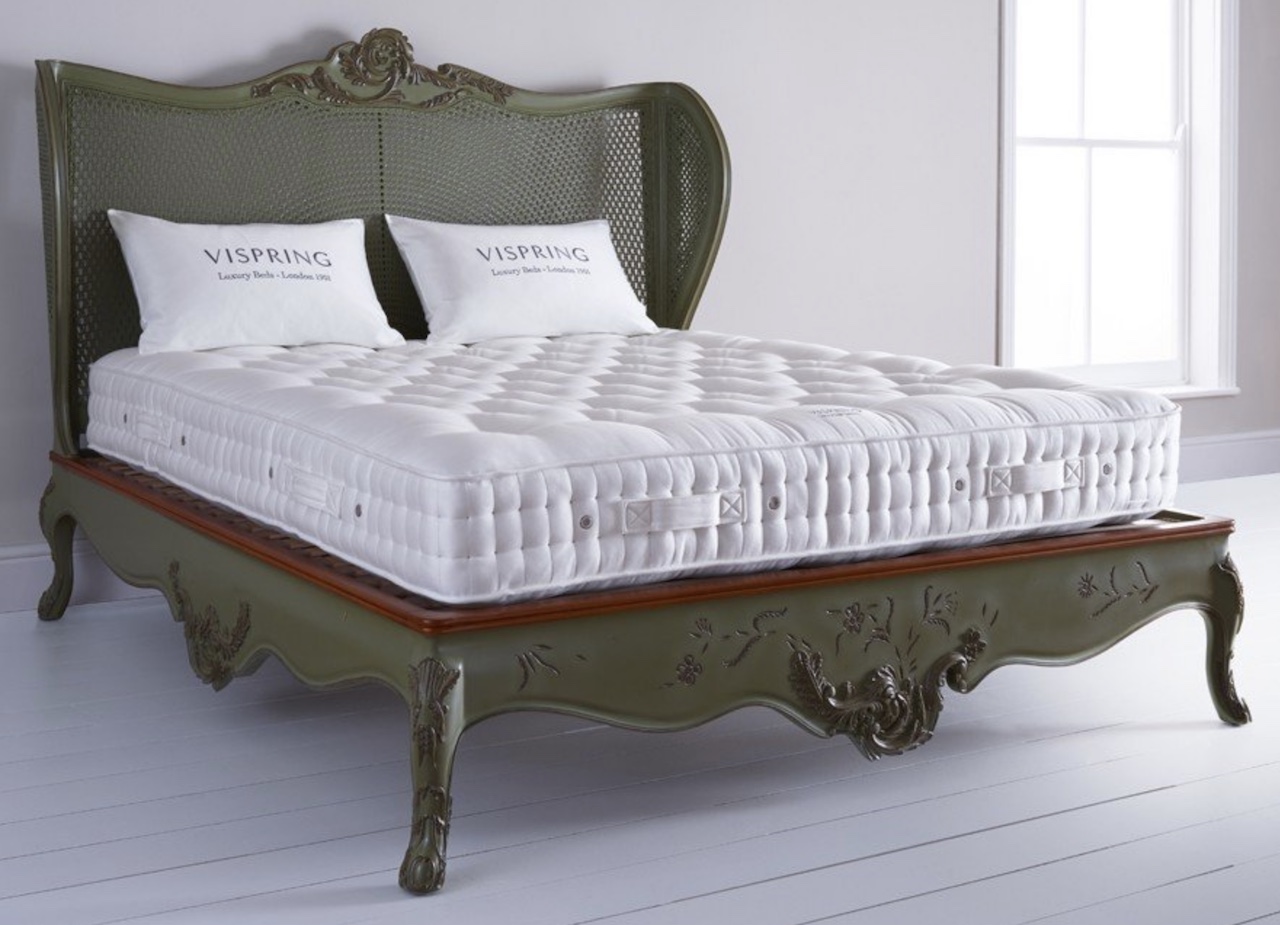
As we have said throughout this site, confusion, complication and frustration exist because manufacturers and retailers do not tell you the detail you need to know. If all mattresses were given a descriptive detail as Vi-Spring give you, your life would be made so much easier and you would not be in a position of remorse weeks or months down the line. The following examples will show you precisely how valuable and beneficial knowing this detail actually is.
Upholstery layers on top of the spring unit provide the ‘comfort’ feel to a mattress starting with the insulator
They then should go from firmest to softest. With the most delicate fibres at the top.
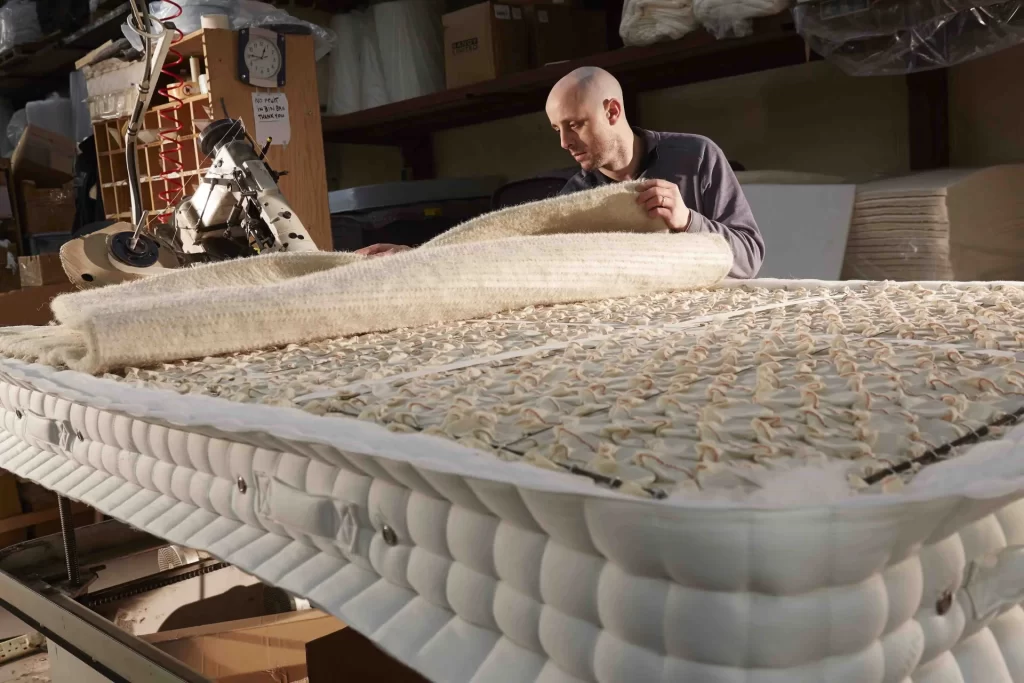

We will be looking in detail at the following Vi-Spring models
1. Vi-spring Regal Superb
2. Vi-spring Bedstead Imperial
1. The Vi-spring Regal Superb
[Official Specification: May 2013: Kingsize ]
- Springs 1.28mm wire springs, 48mm in diameter, sewn in individual calico pockets and hand-formed into a honeycomb nested unit. A total of 1720.
- Mattress border 23cm deep with three rows of genuine hand side-stitching. Eight horizontal handles on King Size and above. Air vents on all sides. Borders upholstered in protective wool, finished with piped ticking.
- Mattress upholstery upholstered with 1000 GSM bonded British fleece wool and cotton, then 1200 gsm long-stranded horsetail blended with British fleece wool and enclosed in a hair-proof cambric cover. Overlaid with a layer of 900 GSM blended real Shetland Isle fleece wool and cotton.
Whats inside the Vispring Mattress?
1. The foundation of the mattress is the spring unit. We can tell by the 1.28mm spring used that this is within the Soft range. It has six active turns and so the flexibility of the single pocketed unit will move and flex under very slight pressure. When all the pockets are combined, the pressure is equalised across the entire unit and so what starts out as a ‘Soft’ individual spring becomes relatively ‘Firmer’ as a whole.
2. On top of this spring unit they place 1000 GSM of bonded wool and cotton, this is a compressed blend of these two components and this part should be stable enough not to flatten or compress whatsoever. But, it should not be so hard as to form a platform on top of the spring units. ‘feeling’ this platform is known ‘a plateau’ and if you feel this when lying on a mattress you will know something is not right within the mattress. Does that make sense as it’s quite difficult to explain?
This part of the mattress is the insulating layer and can be a number of products, but usually, will be a dense product such as the aforementioned BO-WC or a hair pad of sorts.
3. For the support layer, they have used a blend of horsetail and wool weighing in at 1200 GSM. They have identified the wool element as British Fleece wool and coupled with horsetail rather than horsehair you can instantly tell these are premium components used to make the blend. There is no blend ratio which in this particular case it is not necessary to know, however examining the image that is associated with this product you can see the overall colour of this particular upholstery layer is quite dark which indicates to you that a generous layer of the horsetail has been used (this is the most expensive and quality component used within this mattress).
Blends are produced by mixing the two components together to create a new upholstery product and will be weighed out (in this case 1200 GSM) and hand laid across the surface of the underlying Bonded wool cotton. This blend of horsetail and wool will produce a more lofty and softer filling than using a needled product or using Pure Horsetail laid and teased as the bridging support layer.
4. On top of this, they have laid a sheet of cotton calico. This is a natural hair proof membrane that will prevent the individual hairs from working their way through the overlying upholstery to eventually pop through the mattress fabric. As a point of note, even though cotton calico or cambric is a hair-proof covering it is not entirely fail-safe. Individual hairs can still have the tendency to work through the calico weave and still be evident on the top of the mattress. This is known as ‘hair migration’, absolutely impossible to prevent fully.
5. The final layer is a very soft and forgiving blended wool and cotton weighing in at 900 GSM. This is usually at a 50/50 ratio. Cotton is not a natural fire retardant fibre but wool is. However, this mix of wool and cotton produces a fabulously soft and comforting primary layer and the use of this particular blend of upholstery is evident in nearly all high-end mattress models.
6. The mattress fabric (ticking) is then the obvious final layer to complete the mattress.
Summary of Vi-spring Regal Superb
If we study the mechanics of the upholstery used in this particular model we can see that the ‘gradual support’ thesis as outlined above has come to fruition. The springs are the firmest element, followed by the insulator providing a flexible cushion for the springs and a base for the overlying softer element of horsetail and wool. All topped off with a fabulously soft layer of wool and cotton.
When this mattress is tufted, all these components will be compressed further. It has to be realised that prior to adding the mattress ticking the loft of all these loose individual components will be about 8 inches in height. If a finished mattress is about 23cm in height (which this is) it means that all the upholstery has to be compressed from 8 inches to 3 inches each side. This compression gives the mattress the finished tension.
A point to note here is that although the side panel is specified as 23cm, after tufting the upholstery will still be higher than the side panel – a very good indicator of a well upholstered mattress. These undulations between the tufts will obviously be prone to further settlement as you sleep on the mattress to eventually level out across the entire surface.
This is where the anomaly of describing a mattress as soft, medium or firm comes into play. Basically, this will explain that it is the user’s weight applied to the mattress that will be the judge of what tension it is, not the mattress. The resultant mattress should be comfortable and supportive for the user’s weight. If the user is 20 stone then the spring tension will have to be adjusted to a higher gauge ie a 1.58mm or higher if the user is 11 stone or so, then this mattress with this 1.28mm spring tension will be right.
The next example to explain this is a similar spec model within the Vi-Spring range made for the use with bedsteads. We will be looking at The Bedstead Imperial as within this particular model they utilise a pure Horsehair pad as the support layer and we need to see how this affects the underlying and overlying upholstery.
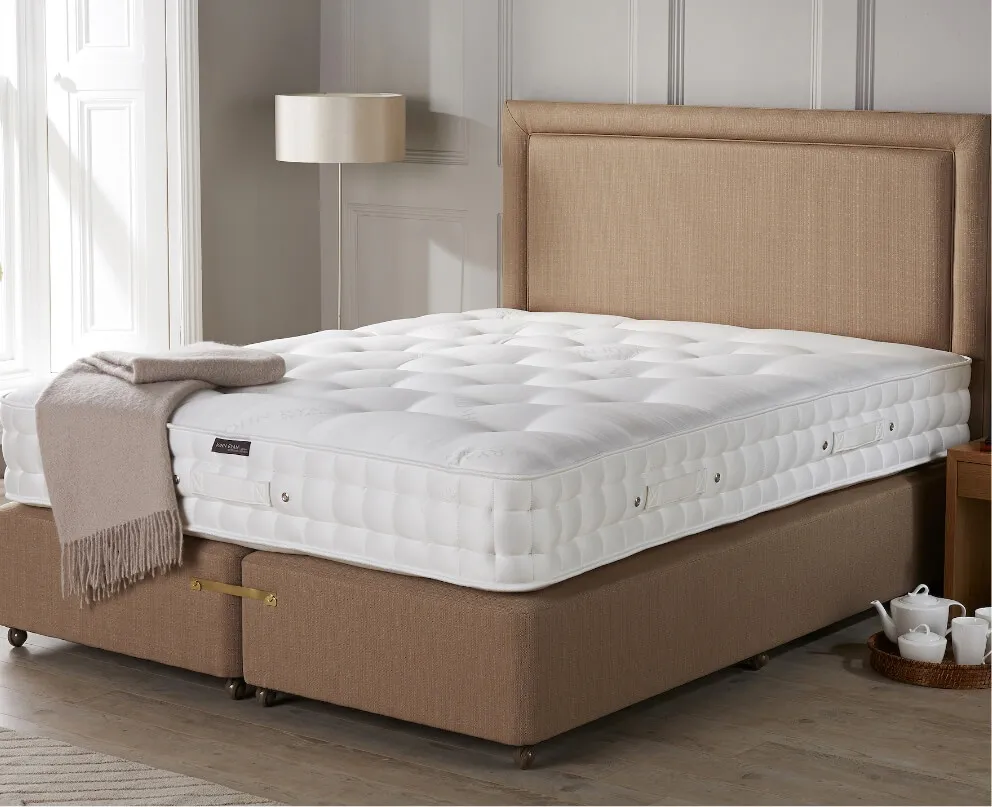
2. The Vi-spring Bedstead Imperial
[Official Specification: May 2013: Kingsize]
- Springs 1.28mm wire springs, 48mm in diameter, sewn in individual calico pockets and hand-formed into a honeycomb nested unit.
- Mattress border 21cm deep with three rows of genuine hand side-stitching. Eight horizontal handles on king size and above. Air vents on all sides. Borders upholstered in protective wool, finished with piped ticking.
- Mattress upholstery Upholstered with a wool spring protector pad, then 1000 GSM bonded British fleece wool and cotton plus 1200 GSM long-stranded horsehair, enclosed in a hair-proof cambric cover and finally overlaid with 200 GSM bamboo and 1200 GSM blended British fleece wool and cotton. Covered with your choice of finest quality Belgian ticking from the Vi-Spring collection. Hand tufted with felt washers.
Whats inside this Vispring mattress?
1. The springs used are exactly the same in this model as they are in The Regal Superb.
2. This has an additional insulating layer of wool and even though there is no associated weight accredited to this product we can easily assume it will be around 500 GSM. This particular mattress is designed for use on a bedstead and the use of the wool spring protector pad is the only additional difference between Vi Springs core range and their Bedstead range. Although I am not 100% sure why this component is added to the models in the bedstead range, I can only assume that it gives the actual springs a greater degree of stability.
3. The insulating layer is added, 1000 GSM bonded wool and cotton. Again this is the same as used in the model above.
4. The support layer is added. This is pure horsehair (not blended) this has a slightly firmer element of tension than the blend but because hair is naturally springy it will be doing the job it is supposed to do quite nicely.
5. The hair proof Cambric sheet is added.
6. A 200 GSM layer of bamboo is added. This is a very soft material and is probably used to enhance the blended wool cotton to follow.
7. The final comfort layer of 1200 GSM of blended wool and cotton is added.
Summary of Vi-spring Bedstead Imperial
The difference between these two models is relatively negligible. The combined upholstery weight of the Regal Superb is 3100 GSM and the combined upholstery weight of this Bedstead Imperial is 3600 GSM plus the wool spring protector pad estimated at 500 GSM. This difference of 1000 GSM or so is rather negligible but taking the mattress build as a whole it would seem to me that even though the actual spring gauge is the same, the Bedstead Imperial will be slightly firmer if the same body weight was applied to this as to the Regal Superb.
Comparison of Vi-spring to Artisan Luxury Mattress
This brings me to another point of interest. In our Artisan Luxury, we have a combined upholstery weight of 4600 GSM. A kilo (1000 GSM) more of upholstery per metre than the Imperial Bedstead. So does this make it a ‘better‘ mattress? Not necessarily so. The more upholstery equates to the more overall tension. The Artisan Luxury comes in at a depth of 24cm and so when tufted we have a greater degree of upholstery to be contained within a mattress of similar depth to the models mentioned above.

It stands to reason that for a users bodyweight of say 8 stone, the user would not have enough body mass to take full advantage of the springs under all this mass of upholstery. Conversely, this would be more suitable for body weights of 12 stone plus. However, that does not leave our lightweight user without a particularly good mattress. Vi-Spring produces a wool and cotton mattress (the Coronet) where the bulk of the upholstery is predominately wool and cotton soft Components but constructed with the same gradual support thesis above.
Unlike the use of a superior support element like horsehair used in the top two examples, the support element in the Coronet is much softer – completely acceptable for Mr or Mrs 8 stone, but certainly not suitable for someone much heavier.
Comparison table of Vi spring mattress models
| Vi Spring Model | John Ryan By Design Model | John Ryan Difference |
|---|---|---|
| The Regal Superb | Artisan 1500 | Slightly firmer comfort layer |
| The Hanbury Superb | Artisan 1500 | Slightly softer overall |
| The Regal Superb | Artisan Tailored Pocket | Firmer support |
| The Regal Superb | Artisan Naturals | |
| The Bedstead Imperial | Artisan Naturals | Firmer support |
| The Heligan Superb | Artisan Naturals | |
| The Regal Superb | Artisan Bespoke 004 | Additional 500 GSM |
| The Melford | Artisan Bespoke 004 | |
| The Devonshire | Artisan Luxury | Uses horsehair & horsetail |
| The Herald Superb | Artisan Bespoke | |
| The Tiara Superb | Artisan Bespoke 002 |
The point to take away from all of this is that although the two examples above describe what it takes to produce a well-crafted mattress it does not follow that they are suitable for everyone. However, a couple of changes to the support elements whether this is springs or the bridging layers can give you an equally good mattress that will be entirely suitable for you.
Summary
This is an extremely extensive subject to talk about in just one post and obviously, the vast range of mattresses out there can be virtually dissected and discussed. With the actual construction being the basis of all mattresses all types and from all manufacturers, it is not possible to go through each and every one.
The fundamental thesis of this post will, of course, assist you in your decision as you will now know what aspects of the mattress to take into consideration. This is a very secretive world and it will be no easy task for you to uncover the nitty-gritty of your purchase. So why not in get in touch for personalised mattress advice, all free of charge, either drop us a note in the form below or call us on 0161 437 4419.

Dreaming of the perfect nights sleep?

Ask us a question
There are over 6000 questions and answers submitted by you on all questions about mattresses and bed problems. Enter a keyword such as Vi Spring, John Lewis beds, bad back or Memory Foam and see if your question has already been answered.
If you can’t find an answer in knowledge hub, ask a new question. We aim to respond to all questions within one working day.
Newsletter
Enter your email to join our newsletter. We’ll send you occasional news and mattress expertise.
